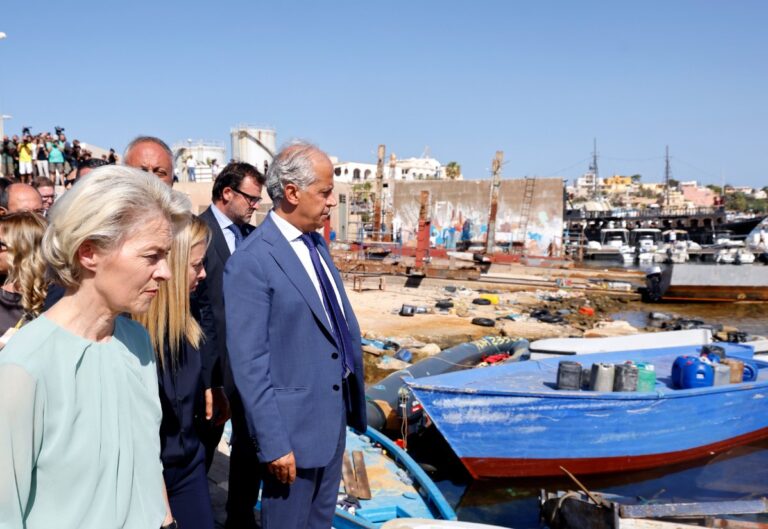A few days ago, Italian PM Giorgia Meloni had invited Ursula Von der Leyen to Lampedusa so that she could see with her own eyes the dramatic situation on the island, including in the wake of citizen uprisings. Let’s see what the visiting EC president had to say and the overall situation.
Table of Contents
Lampedusa: the flow continues
At the Sicilian island of Lampedusa, the transfer machine of the immigration hotspot is still running and has currently about 6,000 guests. In 24 hours about 1,150 migrants have landed. Yesterday, a total of 23 boats landed, totaling more than 1,000 people.
The incoming migrants were transferred to the Contrada Imbriacola hotspot, where 1,950 guests were housed as of 7 a.m. In the morning, the Agrigento prefecture ordered the transfer of 640 migrants who arrived in Catania on the ship “Veronese.”
Von der Leyen, Europe ready for support
Yesterday, September 17, Ursula von der Leyen arrived in Lampedusa. The Commission President accepted an urgent invitation from Italian Prime Minister Giorgia Meloni.
They visited the island together to verify the situation on the ground after a series of landings in recent hours, before traveling to New York to attend the United Nations General Assembly.
“A European challenge, requiring a European response”
“It is very important for me to be here today together with the Italian authorities: illegal immigration is a European problem and Europe must respond.” So said European Commission President Ursula von der Leyen.
“We decide who comes to Europe, not the traffickers,” the Commission President said. “This is how the fight against irregular migration is established in the first place.”
Arrangements with France
Meloni also had a telephone conversation with French President Emmanuel Macron on Saturday. According to Italian sources, the conversation took place after Meloni’s request to von der Leyen and European Council President Charles Michel.
The Élysée Palace reported that Macron and Meloni “discussed developments to be made at the European level regarding joint actions that could be implemented in the central Mediterranean, the prevention of departures with countries of origin and transit, and finally the framework of an agreement on migration to deal with irregular migration flows over a long period of time.”
Read also: Global migration fluxes, the major and most critical routes in 2023
The 10 points plan of the European Union
Supporting Frontex and other European structures for repatriations, patrols and the fight against traffickers, strengthening surveillance at sea and considering new missions, and creating humanitarian corridors to create real alternatives to illegal arrivals.
These are some of the main initiatives included in the 10-point EU action plan presented by Commission President Ursula von der Leyen during her visit to Lampedusa. Here is in detail what the EU plan includes:
1) Concrete support to Italy through Frontex, the asylum agency and others to address the crisis by welcoming and registering and identifying migrants arriving on the island.
2) Intensification of EU efforts to relocate migrants from Lampedusa to other destinations. Thus urging member countries to activate the voluntary solidarity mechanism to take them in.
3) Support of Frontex facilities for returns and intensification, to this end, of relations with countries of origin.
4) Increased actions to combat traffickers, including by strengthening legislation and greater collaboration with countries of origin and transit.
5) Intensification of aerial and naval surveillance through Frontex. But also by considering the possibility, as requested by Italy, of new Sophia-type naval missions.
6) Concrete action against trafficker logistics. I.e., ensuring that boats used for human trafficking are seized and destroyed.
7) EU Asylum Agency staff will work alongside and assist Italian authorities in order to expedite the processing of applications submitted by migrants by rejecting those that are baseless and sending those who submitted them back to their countries of origin.
8) Offer viable alternatives to illegal routes through the strengthening of humanitarian corridors.
9) Strengthen collaboration with UN agencies (UNHCR and IOM) to always ensure the protection of migrants even during assisted returns.
10) To arrive as soon as possible with Tunisia, as part of the implementation of the memorandum of understanding signed last July, to define new projects to combat illegal trafficking of migrants and thus arrive at the release of funds made available by the EU.












